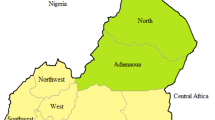Abstract
This article investigates the choice of children’s activities in India and provides recommendations for areas where policy intervention to promote schooling and combat child labor would be most successful. First, we recognize that child schooling and labor are not the sole activities that children can engage in and include idleness as one of the choices. Second, we use a hierarchical model with spatially correlated random effects to analyze the determinants of the choice of children’s activities. Lastly, we recommend that pro-schooling intervention be implemented in districts with favorable attitudes toward schooling and unfavorable attitudes toward idleness, while anti-child-labor interventions be implemented in districts where attitudes toward child labor are less favorable. We thus identify two groups of Indian districts to target appropriate government interventions.
Similar content being viewed by others
References
Barros R, Mendonca R, Velazco T (1994) Is poverty the main cause of child work in urban Brazil? texto para Discussao no. 351. IPEA
Basu K (2002) A note on multiple general equilibria with child labor. Econ Lett 74: 301–308
Basu K, Van PH (1998) The economics of child labor. Am Econ Rev 88(3): 412–427
Beron K, Vijverberg W (2004) Spatial probit: a Monte Carlo simulation. In: Anselin L, Florax R (eds) New advances in spatial econometrics. Springer, Berlin
Besag J (1974) Spatial interaction and the statistical analysis of lattice systems. J R Stat Soc B 35: 192–236
Bhalotra S, Heady C (2003) Child farm labor: the wealth paradox. Discussion paper no. 03/553. Department of Economics, Bristol
Bongaarts J, Watkins SC (1996) Social interactions and contemporary fertility transitions. Popul Dev Rev 22(4): 639–682
Casella G, George E (1992) Explaining the Gibbs samplers. Am Stat 46(3): 167–174
Chib S, Greenberg E (1995) Understanding the Metropolis-Hastings algorithm. Am Stat 49(4): 327–335
Cigno A, Rosati FC, Guarcello L (2002) Does globalization increase child labor?. World Dev 30(9): 1579–1589
Da Silva Leme CM, Wajnman S (2000) A alocacao do tempo dos adolescents brasileiros entre o trabalho e a escola. Unpublished paper
Deb P, Rosati F (2004) Determinants of child labor and school attendance: the role of household unobservables. Unpublished paper
Duryea S, Arends-Kuening M (2002) School attendance, child labor, and local labor markets in urban Brazil. Unpublished paper
Edmonds E, Pavcnik N (2005) The effect of trade liberalization on child labor. J Int Econ 65(2): 401–419
Foster AD, Rosenzweig MR (1996) Technical change and human-capital returns and investments: evidence from the green revolution. Am Econ Rev 86(4): 931–953
Foster AD, Rosenzweig MR (2004) Technological change and the distribution of schooling: evidence from green revolution India. J Dev Econ 74: 87–111
Gelfand A, Smith A (1990) Sampling based approaches to calculating marginal densities. J Am Stat Assoc 85: 398–409
Hogan JW, Tchernis R (2004) Bayesian factor analysis for spatially correlated data, with application to summarizing area-level material deprivation from census data. J Am Stat Assoc 99(466): 314–324
Kochar A (2004) Urban influences on rural schooling in India. J Dev Econ 74: 113–136
Krueger D (2002) The effects of coffee production on child labor and schooling in Brazil. PhD thesis, University of Maryland, College Park
Laird NM, Louis TA (1989) Empirical Bayes ranking methods. J Educ Stat 14: 29–46
LeSage J, Kelley Pace R (2009) Introduction to spatial econometrics. CRC Press, Boca Raton
Lopez-Calva LF (2003) Social norms, coordination, and policy issues in the fight against child labor. In: Basu K, Horn H, Roman L, Shapiro J (eds) International labor standards: history, theory, and policy options. Blackwell, Oxford
Lopez-Calva LF, Miyamoto K (2004) Filial obligations and child labor. Rev Dev Econ 8(3): 489–504
Montgomery MR, Casterline JB (1993) The diffusion of fertility control in Taiwan: evidence from pooled cross-section time-series models. Popul Stud 47: 457–479
Neri MC, Thomas M (2001) Household responses to labor market shocks in Brazil, 1982–1999. Unpublished paper
Ranjan P (1999) An economic analysis of child labor. Econ Lett 64: 99–105
Rosero-Bixby L, Casterline JB (1993) Modeling diffusion effects in fertility transition. Popul Stud 47(1): 147–167
Rosero-Bixby L, Casterline JB (1994) Interaction diffusion and fertility transition in Costa Rica. Soc Forces 73(2): 435–462
Sun D, Tsutakawa R, Speckman P (1999) Posterior distribution of hierarchical models using CAR (1) distributions. Biometrika 86: 341–350
Swaminathan M (1998) Economic growth and the persistence of child labor: evidence from an Indian city. World Dev 26(8): 1513–1528
Wall M (2004) A close look at the spatial correlation structure implied by the CAR and SAR models. J Stat Plan Inference 121(2): 311–324
Watkins SC, Danzi A (1995) Women’s gossip and social change: child birth and fertility control among Italian and Jewish women in the United States, 1920–1940. Gend Soc 9(4): 469–490
Author information
Authors and Affiliations
Corresponding author
Rights and permissions
About this article
Cite this article
Chamarbagwala, R., Tchernis, R. Exploring the spatial determinants of children’s activities: evidence from India. Empir Econ 39, 593–617 (2010). https://doi.org/10.1007/s00181-009-0319-1
Received:
Accepted:
Published:
Issue Date:
DOI: https://doi.org/10.1007/s00181-009-0319-1




